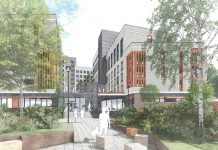Overseas investors are looking beyond the hothouse London market to the UK’s ‘New Frontier’ cities – including Bristol.
That’s according to Colliers International’s Midsummer Retail Report, which was launched to Bristol business leaders at the city’s M Shed on Thursday July 2nd.
The report surveys retail trends across the UK from London’s most prestigious shopping locations to the region’s long suffering High Streets.
Colliers International investment director James Findlater said overseas capital was boosting the fortunes of the UK retail property sector.
“Despite stubbornly high vacancy rates and tentative demand for shops, investment into UK retail property is accelerating with more than £5 billion of acquisitions by overseas investors forecast to take place by the end of the year.
“Initially that buying has been targeting London and large shopping centres, but we are already seeing a ripple effect with buying in regional centres stimulated by the yield gap.
“For this second wave of capital, its new frontier cities are going to be the likes of Manchester, Birmingham, Leeds and Bristol.”
James said new investment was re-shaping our understanding of what counts as ‘prime’ in the retail property sector.
“It is a much narrower band now compared to where it was prior to the financial crash. There was a time when you could find prime retail property in just about every UK city.
“Today you could say that in the retail property sector there are only two sorts of assets that could be strictly defined as prime: the best assets in core London and south east locations, and also a handful of regionally dominant city centres like Bristol.”
Turning to the region’s High Streets, Bristol-based retail director Nick Turk said 2014 had seen little change in rents – as opposed to previous years which had revealed striking variations between towns, sometimes just a few miles apart.
“Our analysis of 421 shopping pitches across the UK shows that – with the exception of London – there is very modest rental growth in our selected locations.”
While 56 out of 57 West towns surveyed showed no change in rents, Plymouth showed an increase of 7 per cent. The South West as a whole showed a 0.3 per cent improvement in rents while Wales remained steady.
Nick said: “But these figures should not hide the fact that towns that went up last year have stayed up while those that went down stayed down.”
Although investment into High Street assets jumped by around 30 per cent to £2.39bn a great deal of that is either within the M25 or in one of the country’s cathedral cities.
Nick concluded: “With fewer retailer failures and store requirements beginning to increase, the sector is edging its way to recovery and we do not see pricing across the High Street softening in the short-term.”
A lot of this improved outlook is actually being driven not by pure retail offers, but by the food and beverage sector.
“Our desire to ‘graze’ while we shop has seen a significant increase in coffee shops, restaurants, bars and grab-and-go convenience food outlets throughout the UK’s High Streets. Given that F&B operators tend to take long leases, this has resonated with investors who are keen to lock into long-term income.”






















